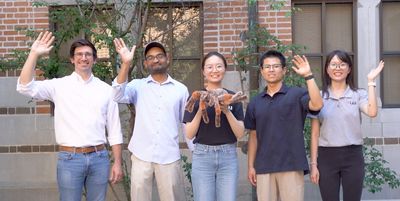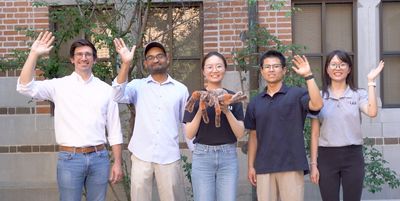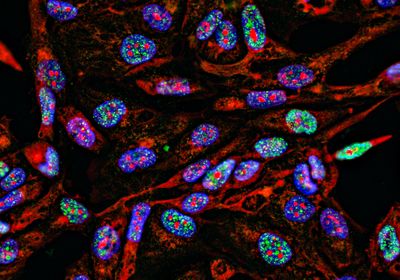ABOVE: (Left to right) Daniel Preston, Anoop Rajappan, Zhen Liu (holding a toy spider), Trevor Shimokusu, and Te Faye Yap won the 2023 Ig Nobel Prize for mechanical engineering. Improbable Research
The 33rd First Annual Ig Nobel Prizes were announced on September 14, 2023. Known to celebrate “research that makes people laugh… then think,” the ten accolades spanned a wide topic spectrum—from eating fossils to imaging the rectum.
Daniel Preston, a mechanical engineer at Rice University, and his team scooped up the mechanical engineering prize for their unique work in necrobotics—a term they came up with for their dead-spider-based gripper invention.1
“Some of our science role models have won [this award] in the past. So, on our end, the whole team is really ecstatic that we were able to get this honor,” said Preston.
Biorobotic researchers often find inspiration in nature, and Preston’s case was no different. A dead spider found in their new laboratory hallway back in 2019 caught the team’s attention. More specifically, the researchers were intrigued by the observation that the dead spider’s legs curled inwards. They went straight to the web—the worldwide one—to understand how spiders move their legs.
See also “Constipation’s Effect on Scorpion Sex Garners Biology Ig Nobel”
In humans, antagonistic muscle pairs such as biceps and triceps allow us to flex and extend our arms. The team learned that spider limbs, however, work differently.
“They have flexor muscles to bring their legs close to the body, but they don’t have any extender muscles,” Preston explained. They rely on a hydraulic system wherein fluid pressure is generated in their prosoma (a body part that connects to their legs) to extend their legs. Once the spider dies, the lack of pressure results in the curled-up limbs.
Researchers have attempted mimicking a spider’s powerful grip in bio-inspired materials before, but the engineers had a unique idea that negated the need for external materials.2,3 If they could apply pressure inside a spider cadaver, they would have an ingenious invention at hand: an animated dead spider with controlled limb movements to grip objects.

“One of the things we are most excited about with this work is that nature builds this robotic actuator or gripper for us,” said Preston. His team intended to leverage the spider’s natural extension and flexion mechanism for their device, which meant they needed to tap into its hydraulic system.
To achieve this, they glued a hypodermic needle into the prosoma region of a euthanized wolf spider and connected the other end of the needle to a syringe. They could now modulate prosomal pressure by pumping in air to control spider leg extension and flexion.
The team demonstrated that the spider-cadaver robots, which moved like arcade claw machines, lifted objects up to 1.3 times their own body weights. The researchers also validated that the gripper could pick up objects of different shapes, sizes, and weights by testing a jumper wire, a foam cube, and a spider.
“One of the biggest advantages is the simplicity of approach. We can make small scale robotic components like these grippers with basically one simple step,” said Preston.
Preston believes that these natural materials with soft padding and a firm grip could be useful for handling fragile materials such as insect samples in field research. The team also hopes to manipulate one spider leg at a time in the future to better understand arachnid locomotion.
References
- Yap TF, et al. Necrobotics: biotic materials as ready-to-use actuators. Adv Sci. 2022;9(29):2201174.
- Kellaris N, et al. Spider-inspired electrohydraulic actuators for fast, soft-actuated joints. Adv Sci. 2021;8(14):2100916.
- Lin Y, et al. A bioinspired stress-response strategy for high-speed soft grippers. Adv Sci. 2021;8(21):2102539.








